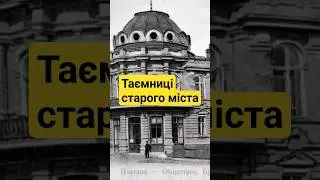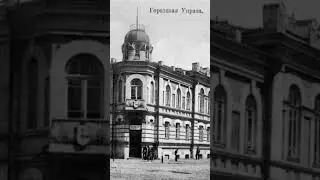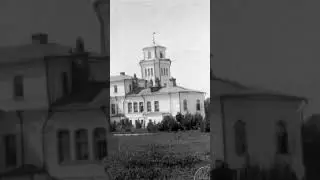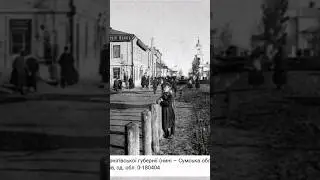TREASURES DROPPROCESS The history of the catacombs of ancient Poltava from Kievan Rus
THE TREASURES OF POLTAVSKOGO DROPPROCESS The history of the catacombs of ancient Poltava from Kievan Rus to the 18th century Part 1
Order individual and group group excursions in Poltava and the region (Dikanka, Opozhnya, Gogoleva, Sorochentsi) by phone +380664978608 or +38098 236 0163 for more details here / gidpoltava
One of the photos used in the video (where there are many stages and the light is lit) is a photo of the dungeons of Ivan the Terrible's time about the same century-old period, which was described by one of the old-timers of the city who, as a child, was in one of the branches of the movement. The entrance to the dungeon was under the church of Sunday of Christ blown up by the Communists in 1936 (in the place of this temple now is the Lysenko Musical College) just opposite the Savior Church. according to the story of the grandfather, the course split up and went towards the Church of the Savior and turned towards the Holy Assumption Church near the Ivan Kotlyarevsky hut.
Ukraine Video story of the old Poltava. Poltava Dungeons - Archaeological Monuments of National Importance taken on the account on December 10, 1945 include underground passages that are located in the area of the Cathedral Square, Pervomaysky Prospekt, Komsomolskaya, Kruglo, Skovoroda streets, on the territory of the former Poltava Cadet Corps, the Victory Park and others places In the Poltava dungeons were found the remains of majolica ceramics, fragments of clay crockery, a variety of things, dishes in the 17th century. Poltava dungeons originate from the times of Kievan Rus, from the natural caves that were used by inhabitants in antiquity as a hiding place from the enemy, the fundamental underground fortifications were probably also erected in the period when the land was part of the Grand Duchy of Lithuania: in 1430, the Poltava was donated the great prince of Lithuania, Vyatov, Alexander Glinsky, who built fortifications here, with time became an integral part of the Poltava Fortress of the 17th and 18th centuries. During the Northern War of 1700-1721, on the eve of the siege of Poltava by the Swedes, the dungeons were fortified and expanded, used by city defenders during the siege. The underground passages through a thick network pierced not only the territory of the fortress (the Old Town, the present territory of the Cathedral Square, the former Uspensky Cathedral, the Church of the Savior, the Museum of Local Lore, the Constitution Square, the Institutskaya Hill), but also the Forstadt (suburbs, from the Sunny and Petrovsky Parks to the Round Lane, on the territory of the Poltava Cadet Corps - from the south to the north and from the street of the Paris Commune to Shevchenko Street - from east to west). Forsadt at different times recorded failures that confirm the presence of traffic in the area of the current streets of Oktyabrskaya, Komsomolskaya, Gogol, Kotlyarevsky, Shevchenko and others.
The researchers (I.A.Zaretsky, V.A.Buchnevich, L.V. Padalka, and others), as well as the old-timers of the city confirm the locations of a masterly built labyrinth system, entrances, exit-lazers, hatches of the type of wells for descent into the dungeon. Basically, they were at a depth of 3-6 centimeters (6.3-12.6 m) from the surface of the earth. Their height was in human growth and more, and the width reached 2.5-3 m. There were also large underground cellars. The entrances to the dungeons were under church and other fundamental structures, from which several branches led to the incisors side - to another church, to the walls of the fortress, in the direction of the river or the monastery.
The underground passages are not accessible for visiting as early as the beginning of the 21st century, they are almost completely destroyed ..
Time, heavy transport, aggressive city development destroyed the architectural memorial and unfortunately, to remove the full-fledged tax is not possible to imagine. Unfortunately, it was not enough for the mind to retain at least a small part of these interesting and mysterious underground structures for tourists and generations to come ...
TREASURES OF POLTAVSKY DRAGONS The history of the catacombs of ancient Poltava from Kievan Rus to the 18th century Part 1 • 🔥 Экскурсия ТАЙНЫ ПОДЗЕМЕЛЬЯ ПОЛТАВА ...
share in social networks take your blogs
Soon on our channel finds finds in the Poltava underground passages of the catacombs
2018 part 2
Thanks for subscribing to the POLTAVA channel
![How to Create and Upload Products (Tutorial) | Awkward Styles Print on Demand [2021]](https://images.videosashka.com/watch/hCIBM6_48_8)

![[ROBLOX] BEE SWARM SIMULATOR SCRIPT PASTEBIN 2023](https://images.videosashka.com/watch/w6YK-I2GIe0)




![[WMT] 이세민 배우 인터뷰 | Actor Lee Se Min Interview](https://images.videosashka.com/watch/aWqdK2cquuI)























